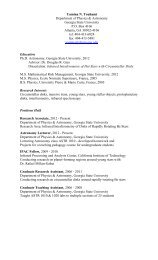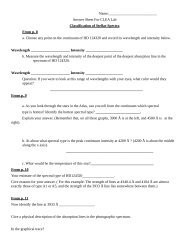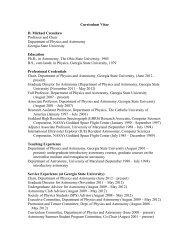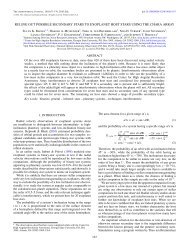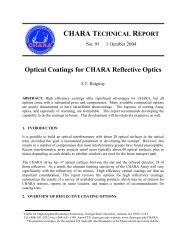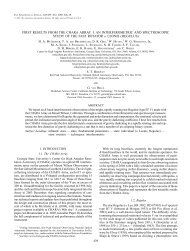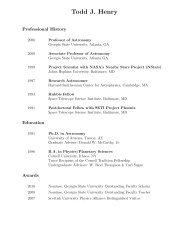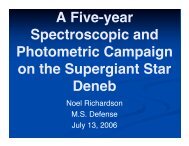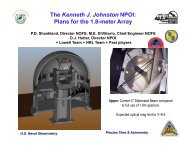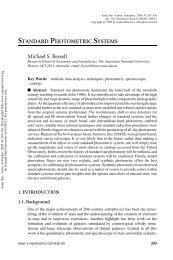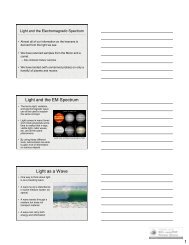Homework 4: Due 11/09/2007 - GSU Astronomy
Homework 4: Due 11/09/2007 - GSU Astronomy
Homework 4: Due 11/09/2007 - GSU Astronomy
You also want an ePaper? Increase the reach of your titles
YUMPU automatically turns print PDFs into web optimized ePapers that Google loves.
ASTRONOMY 1010 <strong>Homework</strong> 4 <strong>Due</strong>: November 9, <strong>2007</strong><br />
Name___________________________________<br />
MULTIPLE CHOICE. Circle the one alternative that best completes the statement or answers the question. If the<br />
question requires work, please show it on this paper. (5 points each)<br />
1) What is differentiation in planetary geology<br />
A) the process by which different types of minerals form a conglomerate rock<br />
B) any process by which a planet's surface evolves differently from another planet's surface<br />
C) any process by which one part of a planet's surface evolves differently from another part of the same<br />
planet's surface<br />
D) any process by which a planet evolves differently from its moons<br />
E) the process by which gravity separates materials according to density<br />
2) Under what circumstances can differentiation occur in a planet<br />
A) The planet must have a rocky surface.<br />
B) The planet must have a molten interior.<br />
C) The planet must be made of both metal and rock.<br />
D) The planet must be geologically active, that is, have volcanoes, planetquakes, and erosion from weather.<br />
E) The planet must have an atmosphere.<br />
3) What is the most important factor that determines the thickness, and therefore strength, of the lithosphere<br />
A) composition<br />
B) internal temperature<br />
C) distance of planet from Sun<br />
D) viscosity<br />
E) pressure<br />
4) The three principal sources of the internal heat of terrestrial planets are<br />
A) accretion, differentiation, and radioactivity.<br />
B) conduction, convection, and eruption.<br />
C) convection, differentiation, and eruption.<br />
D) conduction, differentiation, and accretion.<br />
E) accretion, differentiation, and eruption.<br />
5) Which of the following worlds have the thinnest lithospheres<br />
A) Earth and Mars<br />
B) Mercury and Venus<br />
C) Venus and the Moon<br />
D) Earth and the Moon<br />
E) Earth and Venus<br />
6) The densest planet in the solar system is<br />
A) Saturn B) Earth C) Mercury D) Venus E) Jupiter<br />
1
7) Earth is unique in the following ways except<br />
A) It is the only known place supporting life<br />
B) It has oxygen in its atmosphere<br />
C) It has the densest atmosphere among terrestrial planets<br />
D) It's moon has the largest moon-size to planet-size ratio<br />
E) It is the only Solar System planet with active plate tectonics<br />
8) The coldest place you could step on inside of Saturn's orbit is<br />
A) South pole on Venus<br />
B) Antarctica<br />
C) North Pole on the Moon<br />
D) At the summit of Valles Marineris on Mars<br />
E) Night side of Mercury<br />
9) The tallest known mountain and the deepest known gorge are on<br />
A) Mercury B) Saturn C) Jupiter D) Venus E) Mars<br />
10) Why is Saturn almost as big as Jupiter, despite its smaller mass<br />
A) Saturn is further from the Sun, thus cooler, and therefore less compact.<br />
B) Saturn has a larger proportion of hydrogen and helium than Jupiter, and is therefore less dense.<br />
C) Saturn's rings make the planet look bigger.<br />
D) Jupiter's greater mass compresses it more, thus increasing its density.<br />
E) Jupiter's strong magnetic field constrains its size.<br />
<strong>11</strong>) Which of the following planets cannot be seen with the naked eye<br />
A) Saturn B) Venus C) Neptune D) Mars E) Jupiter<br />
12) Which of the following is the largest in size<br />
A) Jupiter's magnetosphere<br />
B) Jupiter's moon Ganymede<br />
C) Jupiter<br />
D) Olympus Mons<br />
E) Saturn's moon Titan<br />
13) The youngest surface in the Solar System is on<br />
A) Venus B) Titan C) Callisto D) Io E) Earth<br />
14) Among Solar System planets, Jupiter has the strongest Coriolis Effect because<br />
A) It is the largest planet in the Solar System<br />
B) It rotates fastest among planets<br />
C) It has the most moons<br />
D) Both A & B<br />
E) None of the above<br />
15) Which Solar System moon is most likely to have a sub-surface salt-water ocean<br />
A) Triton B) Callisto C) Io D) Europa E) Titan<br />
2
BONUS QUESTION<br />
16) List at least five factors that you consider as important in fostering a life-sustaining environment on Earth.<br />
Briefly justify why you think each factor is significant.<br />
3



